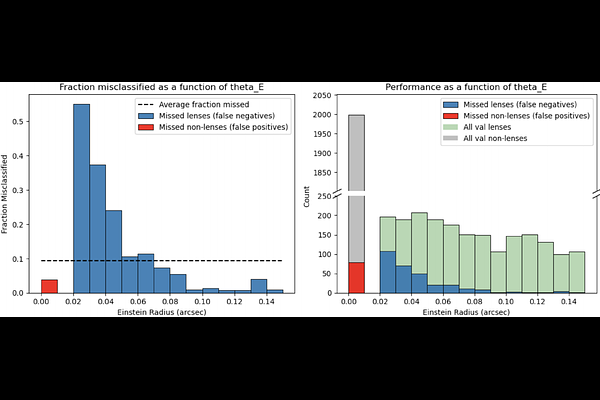ML-Driven Strong Lens Discoveries: Down to $θ_E \sim 0.03''$ and $M_\mathrm{halo}< 10^{11} M_\odot$

ML-Driven Strong Lens Discoveries: Down to $θ_E \sim 0.03''$ and $M_\mathrm{halo}< 10^{11} M_\odot$
Ethan Silver, R. Wang, Xiaosheng Huang, A. Bolton, C. Storfer, S. Banka
AbstractWe present results on extending the strong lens discovery space down to much smaller Einstein radii ($\theta_E\lesssim0.03''$) and much lower halo mass ($M_\mathrm{halo}<10^{11}M_\odot$) through the combination of JWST observations and machine learning (ML) techniques. First, we forecast detectable strong lenses with JWST using CosmoDC2 as the lens catalog, and a source catalog down to 29th magnitude. By further incorporating the VELA hydrodynamical simulations of high-redshift galaxies, we simulate strong lenses. We train a ResNet on these images, achieving near-100\% completeness and purity for ``conventional" strong lenses ($\theta_E\gtrsim 0.5''$), applicable to JWST, HST, the Roman Space Telescope and Euclid VIS. For the first time, we also search for very low halo mass strong lenses ($M_{halo}<10^{11}M_\odot$) in simulations, with $\theta_E\ll 0.5''$, down to the best resolution ($0.03''$) and depth (10,000~sec) limits of JWST using ResNet. A U-Net model is employed to pinpoint these small lenses in images, which are otherwise virtually impossible for human detection. Our results indicate that JWST can find $\sim 17$/deg$^2$ such low-halo-mass lenses, with the locations of $\sim 1.1$/deg$^2$ of these detectable by the U-Net at $\sim100$\% precision (and $\sim 7.0$/deg$^2$ at a 99.0\% precision). To validate our model for finding ``conventional" strong lenses, we apply it to HST images, discovering two new strong lens candidates previously missed by human classifiers in a crowdsourcing project (Garvin et al. 2022). This study demonstrates the (potentially ``superhuman") advantages of ML combined with current and future space telescopes for detecting conventional, and especially, low-halo-mass strong lenses, which are critical for testing CDM models.